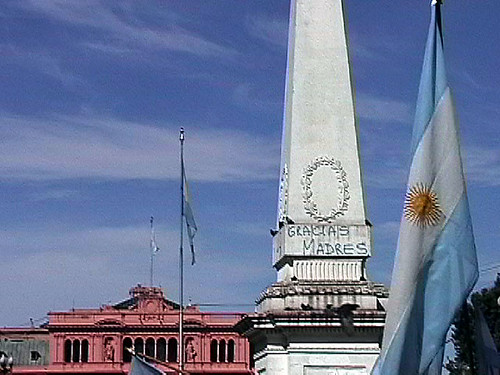[This photo is from February 2003.]

As I mentioned yesterday, 30 April marks the 30th year of the Madres de Plaza de Mayo. Until seeing Clarín this morning I didn’t realize that one of the Madres’ groups – Línea Fundadora – had its celebration on Sunday. (Political differences have fragmented the Madres). This afternoon at 3 will begin a long concert in the Plaza to celebrate the Madres led by Hebe de Bonafini.
I just noticed on the official Madres Web site a scrolling banner about today’s gathering that says “Un sueño: el Socialismo” and that Cuban cultural minister Abel Prieto will be one of today’s participants. …..I’m going to refrain from an editorial comment but make of that what you will.
Anyway, let’s go back to the early days of the Madres, thirty years ago, before the Madres fragmented into different organizations. I want to quote from the book Searching for Life: The Grandmothers of the Plaza De Mayo and the Disappeared Children of Argentina about an early gathering of the Madres in the Plaza. While this book deals mostly with the Abuelas de Plaza de Mayo (yet another group of Madres but one that doesn’t march in the Plaza), the book is excellent reading.
This is from an interview with Haydée Vallino de Lemos conducted by the book’s author Rita Arditti in 1993. (Haydée son as well as her daughter – who was 8 months pregnant – both disappeared):
I was a member of the Mothers of Plaza de Mayo. Yes, those that go around in the Plaza. At first when my children disappeared I just laid down in bed, looking at the ceiling, blank. That was all I could do. My weight went down to forty kilos. One day my husband brought the newspaper and said: “Look, people are getting together.” I jumped up saying, “Then it is not me alone, there are others.” I started to go to the Ministry of the Interior. There I met a woman who said to me: “Why don’t you come on Thursdays to the Plaza de Mayo? Take a little nail; that is how they will recognize you.” So I went, and I sat on a bench and my husband sat a little away from me. I had this little nail in my hand, and I saw that the others also had a little nail, and that is how I knew it was them.
At a demonstration, a woman began to tell me her story and, when she learned that I had a pregnant daughter disappeared, she took out a little notebook and put me on the list. She also had a disappeared pregnant daughter….
In the Plaza we secretly passed notes about where our meetings would be. We met in churches…we met in my house, in my sister’s house…My sister lived on the twelfth floor, and we did not want to take the elevator and make noise. We were quite a few, and the meeting was at an hour when the janitor was sleeping. So we went tiptoeing to the twelfth floor. And then, what a moment! When we got together, we discussed about whom to send letters, we collected signatures, we brainstormed. Each meeting was bigger than the one before. We were simply housewives. Most of us had never done anything outside the home. I did not even know how to take a bus alone. I was not used to going out without my husband. Even now I do not think I could do the things I did then.
Regarding the little nail, a footnote explains:
At one of the early gatherings, a Mother had picked up a rusty nail from the ground and put it on her lapel. “It is a symbol of suffering, like the nails of Christ,” she said. After that, other Mothers started to use nails to recognize each other.